Steam is Where It’s at, at Itz’At Academy
The MoRe Campaign is making waves across the country, highlighting institutions that go above and beyond for their students. We’ve traveled to every corner of Belize to tell the stories of deserving schools and students. This week, we visited the Itz’At Academy right here in Belize City. Despite opening its doors only a year ago, the school embodies the essence of the MoRe Campaign across all pillars defined by the Ministry of Education. Sabreena Daly stopped by to see what the STEAM Academy is achieving under the pillar of Creativity and Innovation, and if you know anything about Itz’At, STEAM is indeed where it’s at. Here’s that story.
Sabreena Daly, Reporting
They call it the Maker Space, a place where ideas transform into reality. In this room, first-form students engage in activities ranging from coding for robotics and woodworking to 3D printing. Lionel Palacio, the Key Learning Area teacher at Itz’At Academy, oversees this innovative space, with a particular focus on Digital Art.
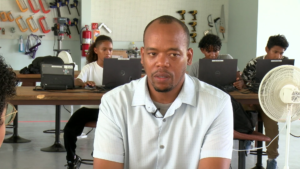
Lionel Palacio
Lionel Palacio, Key Learning Area Teacher, Itz’At Steam Academy
“So, the class we are currently in right now is called Maker and Maker allows the students to tinker with the different types of tools and skills and produce tangible stuff.”
Students are busy creating a logo for a business. Palacio explains that the curriculum provides an integrated learning experience, where each subject seamlessly connects with others.
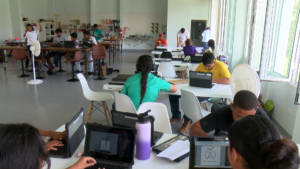 Lionel Palacio
Lionel Palacio
“Most of our subjects or courses are connected. Students work on their digital art logo. So this cycle is called Promote It. And they would create a logo in Digital Art, which is a separate subject, but that very logo, they had to do research on their favorite logo. Once they have learned that, they start to tinker and design their own logo according to their passion. So the objective was what is your passion? Okay. Maybe your one is food. So what type of food? And so you think about maybe you could create a business. Now you need to create a face for a business, which is a logo.”
Thirteen-year-old Jayzden Nembhard proudly shows us her project—a logo for her business, “Learn Together.” Her idea aims to engage students interested in the same subjects she is studying.
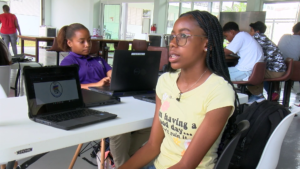
Jayzden Nembhard
Jayzden Nembhard, Student, Itz’At Academy
“My idea was that I wanted to have a company that could help students coming into high schools like ours that is basically technology based to learn more about technology. So I think in my company, I would teach about the basics of technology, like for students who came from primary schools that don’t use computers, that they could learn before they come to high school, maybe like a summer program or something like that.”
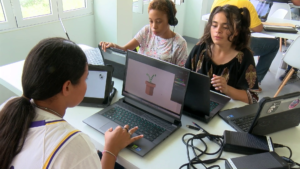 Lionel Palacio
Lionel Palacio
“So what they’re doing now, they’re solving on their own, which of these machines will best illustrate their logo. And today is going to be like a test run. So if you’re going to run it on the vinyl, It might not come out so good until you go back and iterate. Maybe there’s something that is clogging. Maybe you need to reduce some tone or color or something until you would have done that. So, they’re basically going to test it on whatever machine they want.”
Itz’At Academy exemplifies what competency-based learning can achieve when students are given the opportunity to be critical thinkers and problem solvers.
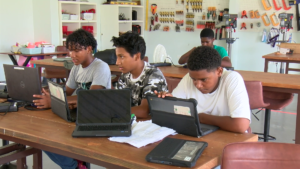 Lionel Palacio
Lionel Palacio
“The reason I’m here is because education is different. It is the future. It is having students have access to state of the art machines, having access to new information, having access to how to become entrepreneurs, autonomous thinkers. And the typical high school can only do that to a limit. An example of this is that we teach them how to research, allowing them to gather these tools and skills on how to do research. It’s a gateway for them to further their education and also become lifelong learners. And so if we’re looking at competency based learning, it is more of what the student can do with knowledge and skill and present it in a way that is original–authentic. It’s not like a guided activity where everybody’s producing the same thing. So, it aligns in terms of having our students be competent in what they’re doing.”
Competency-based learning is also evident in their creative and innovative approach to education. In this class, students engage in collaborative projects and demonstrate digital literacy.
 Lionel Palacio
Lionel Palacio
“What we do here is students are allowed their phone, of course with a license. The license allows them to know how to use their phone. They agree to use a phone. So we teach them how to use their devices properly for productivity. And we introduce softwares to them. Instead of using paper, they use their Chrome books to document their work, to save their work. So because we’re getting to a digitized world, allowing the students to be comfortable with that aspect makes it very easy for them to put things in and bring things out.”
Christine Coc, the vice principal of the institution, oversees a cohort of sixty-four students. The Ministry of Education’s four-point scale guides their progress.
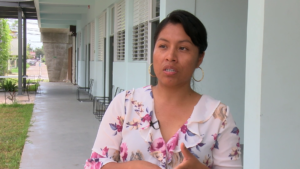
Christine Coc
Christine Coc, Vice Principal, Itz’At Academy
“We use the four point scale that the ministry has. You have emerging, developing, achieving, and mastery. And so what we do is we say when you start off and you have never used a laser cutter before, you might be at emerging, so you will know some of the information, but as we start to teach, when you start to practice, then you start moving up the levels that eventually you don’t need a teacher’s help. You have now mastered how to use the machines. And so for us, that’s what competency is all about. Are you able to do the work?”
Elroy Tucker Jr. eagerly shares his prototype and concept with us. Displayed on the screen, he describes a coded animation that, once refined, could support his business idea for an animated game, centered around a character with a personality disorder.
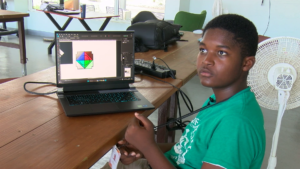
Elroy Tucker Jr.
Elroy Tucker Jr. , Student, Itz’At Steam Academy
“My logo is mainly representing the people who have a special disorder called Dissociative Personality Disorder. So my initial idea was to make a video game about it where you would interact with the world with different personalities inside of one singular host. And it was a really interesting concept to think about. I hope that I can use this same logo when I make the game in the future.”
 Interacting with students at the STEAM academy reveals a bright future for Belize when forward-thinking education is embraced. Coc’s goal is to equip students with skill sets that make them highly desirable to employers or capable of creating their own businesses.
Interacting with students at the STEAM academy reveals a bright future for Belize when forward-thinking education is embraced. Coc’s goal is to equip students with skill sets that make them highly desirable to employers or capable of creating their own businesses.
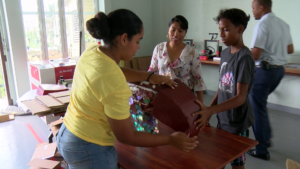 Christine Coc
Christine Coc
“For me, when I see them, my vision of them walking down that stage is for them to be proud and say, Yeah, I got my diploma today and tomorrow I already have a job. Or I don’t have a job with somebody, but I can make my own business because I can design stickers. I can design logos. You give me a sketch, I can draw it for you. And so for me, that is the vision that I have for an Itz’At student.”
Looking on the Bright Side, I’m Sabreena Daly.







Facebook Comments